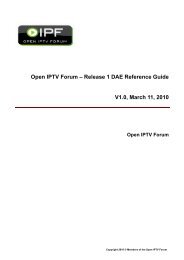OIPF Release 1 Specification Profiles [V1.0 ... - Open IPTV Forum
OIPF Release 1 Specification Profiles [V1.0 ... - Open IPTV Forum
OIPF Release 1 Specification Profiles [V1.0 ... - Open IPTV Forum
You also want an ePaper? Increase the reach of your titles
YUMPU automatically turns print PDFs into web optimized ePapers that Google loves.
<strong>OIPF</strong><strong>Release</strong> 1 <strong>Specification</strong><strong>Profiles</strong>[<strong>V1.0</strong>] – [2009-10-08]<strong>Open</strong> <strong>IPTV</strong> <strong>Forum</strong>
Page 2 (31)<strong>Open</strong> <strong>IPTV</strong> <strong>Forum</strong>Postal address<strong>Open</strong> <strong>IPTV</strong> <strong>Forum</strong> support office address650 Route des Lucioles - Sophia AntipolisValbonne - FRANCETel.: +33 4 92 94 43 83Fax: +33 4 92 38 52 90Internethttp://www.oipf.tvDisclaimerThe <strong>Open</strong> <strong>IPTV</strong> <strong>Forum</strong> members accept no liability whatsoever for any use of this document.Copyright NotificationNo part may be reproduced except as authorized by written permission.Any form of reproduction and/or distribution of these works is prohibited.Copyright 2009 © Members of the <strong>Open</strong> <strong>IPTV</strong> <strong>Forum</strong> e.V.All rights reserved.Copyright 2009 © Members of the <strong>Open</strong> <strong>IPTV</strong> <strong>Forum</strong> e.V.
Page 3 (31)Contents1 SCOPE (INFORMATIVE) ........................................................................................................................................ 72 REFERENCES ........................................................................................................................................................... 82.1 NORMATIVE REFERENCES ................................................................................................................................... 82.1.1 Standard References ...................................................................................................................................... 82.1.2 <strong>Open</strong> <strong>IPTV</strong> <strong>Forum</strong> References ...................................................................................................................... 82.2 INFORMATIVE REFERENCES ................................................................................................................................ 83 TERMINOLOGY AND CONVENTIONS ............................................................................................................... 93.1 CONVENTIONS ...................................................................................................................................................... 93.2 DEFINITIONS ......................................................................................................................................................... 93.3 ABBREVIATIONS ................................................................................................................................................. 104 RELEASE 1 <strong>IPTV</strong> SOLUTION PROFILES (INFORMATIVE) ......................................................................... 135 OPEN INTERNET PROFILE ................................................................................................................................. 145.1 <strong>IPTV</strong> SERVICES .................................................................................................................................................. 145.2 RESIDENTIAL NETWORK ................................................................................................................................... 145.2.1 WAN Gateway ............................................................................................................................................ 145.2.2 IMS Gateway .............................................................................................................................................. 145.2.3 Application Gateway .................................................................................................................................. 145.2.4 OITF ........................................................................................................................................................... 145.3 SERVICE PROVIDER DISCOVERY ENTRY POINTS ............................................................................................... 155.4 SERVICE DISCOVERY AND CONTENT METADATA .............................................................................................. 155.5 AUTHENTICATION METHODS ............................................................................................................................. 155.6 CONTENT AND SERVICE PROTECTION .............................................................................................................. 155.7 SVG TINY V1.2 .................................................................................................................................................. 155.8 REMOTE MANAGEMENT ..................................................................................................................................... 156 BASELINE MANAGED PROFILE ........................................................................................................................ 166.1 <strong>IPTV</strong> SERVICES .................................................................................................................................................. 166.2 RESIDENTIAL NETWORK ................................................................................................................................... 166.2.1 WAN Gateway ............................................................................................................................................ 166.2.2 IMS Gateway .............................................................................................................................................. 166.2.3 Application Gateway .................................................................................................................................. 166.2.4 OITF ........................................................................................................................................................... 166.3 SERVICE PROVIDER DISCOVERY ENTRY POINTS ............................................................................................... 176.4 SCHEDULED CONTENT AND STREAMED COD SERVICE ENABLERS .................................................................. 176.5 AUTHENTICATION METHODS ............................................................................................................................. 176.6 CONTENT AND SERVICE PROTECTION .............................................................................................................. 176.7 OITF CAPABILITIES ........................................................................................................................................... 176.7.1 SVG Tiny V1.2 ........................................................................................................................................... 176.7.2 Multiple concurrent video stream decoding support ................................................................................... 176.8 REMOTE MANAGEMENT .................................................................................................................................... 186.9 PROFILE SUPPORT UPGRADE.............................................................................................................................. 187 ENHANCED MANAGED PROFILE ..................................................................................................................... 197.1 <strong>IPTV</strong> SERVICES .................................................................................................................................................. 197.2 RESIDENTIAL NETWORK ................................................................................................................................... 197.2.1 WAN Gateway ............................................................................................................................................ 197.2.2 IMS Gateway .............................................................................................................................................. 197.2.3 AG ............................................................................................................................................................... 197.2.4 OITF ........................................................................................................................................................... 197.3 SCHEDULED CONTENT AND STREAMED COD SERVICE ENABLERS .................................................................. 197.4 BROADBAND CONTENT GUIDE .......................................................................................................................... 207.5 AUTHENTICATION METHODS ............................................................................................................................. 207.6 CONTENT AND SERVICE PROTECTION .............................................................................................................. 207.7 REMOTE MANAGEMENT .................................................................................................................................... 208 SPECIFICATION OF PROFILE FEATURES ..................................................................................................... 218.1 <strong>IPTV</strong> SERVICES SUPPORT IN THE OITF ............................................................................................................ 22Copyright 2009 © Members of the <strong>Open</strong> <strong>IPTV</strong> <strong>Forum</strong> e.V.
Page 4 (31)8.2 MEDIA FORMATS ............................................................................................................................................... 228.3 CONTENT METADATA ........................................................................................................................................ 238.4 PROTOCOLS ........................................................................................................................................................ 258.5 DECLARATIVE APPLICATION ENVIRONMENT ................................................................................................... 278.6 PROCEDURAL APPLICATION ENVIRONMENT .................................................................................................... 308.7 AUTHENTICATION, CONTENT PROTECTION AND SERVICE PROTECTION ........................................................ 31Copyright 2009 © Members of the <strong>Open</strong> <strong>IPTV</strong> <strong>Forum</strong> e.V.
Page 5 (31)FiguresNo figures are included.TablesTable 1 Legend for status in the <strong>Profiles</strong> ............................................................................................................................... 21Table 2 <strong>IPTV</strong> Service support profiling ................................................................................................................................. 22Table 3 Media formats profiling ............................................................................................................................................. 23Table 4 Content Metadata profiling ....................................................................................................................................... 24Table 5 Protocols profiling ...................................................................................................................................................... 26Table 6 DAE features profiling ............................................................................................................................................... 30Table 7 Authentication and CSP profiling ............................................................................................................................ 31Copyright 2009 © Members of the <strong>Open</strong> <strong>IPTV</strong> <strong>Forum</strong> e.V.
Page 6 (31)ForewordThis specification has been produced by the <strong>Open</strong> <strong>IPTV</strong> <strong>Forum</strong> (<strong>OIPF</strong>).This specification accompanies the set of specifications (Volumes 1-7) that define version 1.1 of the <strong>Open</strong> <strong>IPTV</strong> <strong>Forum</strong><strong>Release</strong> 1 <strong>IPTV</strong> Solution.This specification defines three profiles for the <strong>OIPF</strong> <strong>Release</strong> 1 <strong>IPTV</strong> Solution:• The <strong>Open</strong> Internet Profile,• The Baseline Managed Profile, and• The Enhanced Managed Profile.The three profiles are heirarchical in the sense that the <strong>Open</strong> Internet Profile is formed of a sub-set of the features of theBaseline Managed Profile, and that the Baseline Managed Profile is formed of a sub-set of the features of the EnhancedManaged Profile.Note that these profile names are defined as technical terms and as such are not intended to be used for any logo mark orsimilar purpose.If additional profiles are defined for the <strong>Release</strong> 1 <strong>IPTV</strong> Solution, these will be included in future revisions of thisspecification.Copyright 2009 © Members of the <strong>Open</strong> <strong>IPTV</strong> <strong>Forum</strong> e.V.
Page 7 (31)1 Scope (Informative)The <strong>Open</strong> <strong>IPTV</strong> <strong>Forum</strong> <strong>Release</strong> 1 <strong>IPTV</strong> Solution provides the specification for an end-to-end platform for thedeployment of the set of <strong>Release</strong> 1 <strong>IPTV</strong> Services. The <strong>Open</strong> <strong>IPTV</strong> <strong>Forum</strong> has developed an end-to-end solution to allowany consumer end-device, compliant to the <strong>Open</strong> <strong>IPTV</strong> <strong>Forum</strong> specifications, to access enriched and personalised <strong>IPTV</strong>services either in a managed or a non-managed network.The <strong>Release</strong> 1 <strong>IPTV</strong> Solution specification provides multiple options for some features. This specification complementsthe <strong>IPTV</strong> Solution specification by defining <strong>OIPF</strong> implementation and deployment profiles that remove uncertainty aboutwhat features are required in an implementation. Any implementation based on the <strong>Release</strong> 1 <strong>IPTV</strong> Solution specificationmust be in adherence to one of the profiles defined in the present specification in order to claim <strong>Open</strong> <strong>IPTV</strong> <strong>Forum</strong>compliance.<strong>Profiles</strong> define the minimum set of features that a terminal must support in order to be able to claim compliance to thatprofile, and the maximum set of features that a service can rely on being present in the OITF. Some features are optionalwithin a profile, and a service can use capability exchange protocols to determine if a terminal supports such features.Some features are mandatory or optional depending on the configuration of the OITF, for example whether the OITF isequipped with local storage or a broadcast tuner.It is expected that this specification will be used as a key input to the interoperability and certification programs that willbe defined for the <strong>Release</strong> 1 Solution by the <strong>Open</strong> <strong>IPTV</strong> <strong>Forum</strong>.Copyright 2009 © Members of the <strong>Open</strong> <strong>IPTV</strong> <strong>Forum</strong> e.V.
Page 8 (31)2 References2.1 Normative References2.1.1 Standard References[RFC2119][TS102034][A137][TS102539]RFC 2119 (1997-03), IETF, “Key words for use in RFCs to Indicate Requirement Levels”.ETSI, TS 102 034 V1.4.1 / DVB Bluebook A086r8, “Digital Video Broadcasting: Transport of MPEG-2 BasedDVB Services over IP Based Networks”DVB Blue Book A137, “Signalling and carriage of interactive applications and services in hybridbroadcast/broadband environments”ETSI, TS 102 539 V1.2.1 (2008-04), “Digital Video Broadcasting: Carriage of Broadband Content Guide (BCG)information over Internet Protocol”2.1.2 <strong>Open</strong> <strong>IPTV</strong> <strong>Forum</strong> References[<strong>OIPF</strong>_SERV] <strong>Open</strong> <strong>IPTV</strong> <strong>Forum</strong>, “Services and Functions for <strong>Release</strong> 1”, September 2007.[<strong>OIPF</strong>_REQS] <strong>Open</strong> <strong>IPTV</strong> <strong>Forum</strong>, “Service and Platform Requirements”, V1.1, July 2008.[<strong>OIPF</strong>_ARCH] <strong>Open</strong> <strong>IPTV</strong> <strong>Forum</strong>, “Functional Architecture – V1.2”, January 2009.[<strong>OIPF</strong>_OVIEW] <strong>Open</strong> <strong>IPTV</strong> <strong>Forum</strong>, “<strong>Release</strong> 1 <strong>Specification</strong>, Volume 1 - Overview”, V1.1, October 2009.[<strong>OIPF</strong>_MEDIA] <strong>Open</strong> <strong>IPTV</strong> <strong>Forum</strong>, “<strong>Release</strong> 1 <strong>Specification</strong>, Volume 2 - Media Formats”, V1.1, October 2009.[<strong>OIPF</strong>_META] <strong>Open</strong> <strong>IPTV</strong> <strong>Forum</strong>, “<strong>Release</strong> 1 <strong>Specification</strong>, Volume 3 - Content Metadata”, V1.1, October 2009.[<strong>OIPF</strong>_PROT] <strong>Open</strong> <strong>IPTV</strong> <strong>Forum</strong>, “<strong>Release</strong> 1 <strong>Specification</strong>, Volume 4 – Protocols”, V1.1, October 2009.[<strong>OIPF</strong>_DAE][<strong>OIPF</strong>_PAE][<strong>OIPF</strong>_CSP]<strong>Open</strong> <strong>IPTV</strong> <strong>Forum</strong>, “<strong>Release</strong> 1 <strong>Specification</strong>, Volume 5 - Declarative Application Environment”, V1.1, October2009.<strong>Open</strong> <strong>IPTV</strong> <strong>Forum</strong>, “<strong>Release</strong> 1 <strong>Specification</strong>, Volume 6 - Procedural Application Environment”, V1.1, October2009.<strong>Open</strong> <strong>IPTV</strong> <strong>Forum</strong>, “<strong>Release</strong> 1 <strong>Specification</strong>, Volume 7 - Authentication, Content Protection and ServiceProtection”, V1.1, October 2009.2.2 Informative ReferencesThe present document makes no informative references.Copyright 2009 © Members of the <strong>Open</strong> <strong>IPTV</strong> <strong>Forum</strong> e.V.
Page 9 (31)3 Terminology and Conventions3.1 ConventionsThe key words “MUST”, “MUST NOT”, “REQUIRED”, “SHALL”, “SHALL NOT”, “SHOULD”, “SHOULD NOT”,“RECOMMENDED”, “MAY”, and “OPTIONAL” in this document are to be interpreted as described in [RFC2119].All sections and appendixes are normative, unless they are explicitly indicated to be informative.3.2 DefinitionsTermAccess NetworkApplicationConsumer DomainConsumer NetworkConsumer(s)ContentContent GuideContent on Demand(CoD)Content ProtectionContent ProviderEnd User(s)Internet<strong>IPTV</strong> Service Provider<strong>IPTV</strong> Solution<strong>IPTV</strong> Terminal Function(ITF)Local Storagenative HNI-IGI functionnon-native HNI-IGIfunctionnPVRPortalProgramDefinitionThe network infrastructure used by the Access Provider to deliver <strong>IPTV</strong> services to the Consumer.The access network infrastructure is used for the delivery of the content and may include quality of servicemanagement to ensure that appropriate network resources are available for the delivery of the content.Collection of assets and logic that together provide a Service to the User. Assets and logic may resideeither in an application Server or in the ITF or both.The domain where the <strong>IPTV</strong> services are consumed. A consumer domain can consist of a single terminalor a network of terminals and related devices for service consumption.The local area network in which the <strong>IPTV</strong> Terminal Function is located. Consumer Networks includeResidential Networks, hot spots, hotel networks etc.See End User(s).An instance of audio, video, audio-video information, or data.An on-screen guide to Scheduled Content and Content on Demand, allowing a User to navigate, select,and discover content by time, title, channel, genre, etc.A Content on Demand service is a service where a user can select the individual content items they wantto watch from the list of available content. Consumption of the content is started upon user request.Means to protect content from unauthorized usage such as re-distribution, recording, playback, duplicationetcEntity that provides Content and associated usage rights to the <strong>IPTV</strong> Service Provider.The individual(s) (e.g., members of the same family) who actually use the <strong>IPTV</strong> Services.The Internet is the worldwide, publicly accessible network of interconnected computer networks thattransmit data by packet switching using the standard Internet Protocol (IP).Entity that offers <strong>IPTV</strong> Services and which has a contractual relationship with the Subscriber.Defined by the <strong>Forum</strong>’s specifications.The functionality within the Consumer Network that is responsible for terminating the media and controlfor an <strong>IPTV</strong> Service.Content storage within the administrative realm of the <strong>IPTV</strong> Service Provider, but not in their physicalenvironment (for example, local storage could be a partition of storage located in the residential networkand allocated to the Service Provider to pre-load CoD).The procedures for interactions on the HNI-IGI interface are provided as part of the OITF implementation- typically in native code.The procedures for interactions on the HNI-IGI interface are provided by a service provider in JavaScriptas part of a DAE application.Network based Personal Video Recorder. Provision of PVR functionality whereby the content is stored inthe <strong>IPTV</strong> Service Provider domain. The nPVR allows a user to schedule recording of scheduled contentprograms. The user can later select the content they want to watch from the recorded content.A function of a Service Platform that provides an entry point to individual <strong>IPTV</strong> Services to Users via aGUI.A segment of Scheduled Content with a defined beginning and end.Copyright 2009 © Members of the <strong>Open</strong> <strong>IPTV</strong> <strong>Forum</strong> e.V.
Page 10 (31)TermProgram GuidePush CoDResidential NetworkScheduled ContentServiceService AccessProtectionService PlatformProviderService ProtectionSession PortabilitySubscriberSubscriber ProfileTrick ModeUser ProfileUser(s)DefinitionSee Content Guide.A type of Content on Demand where the content is pre-loaded to the ITF local storage by the ServiceProvider. The user has no direct control of what content is pre-loaded; however the Service Provider maymake the choice based on user preferences and habits. Content is available for direct consumption after theuser selection is confirmed.The local network of devices (gateways and terminals) at the End User’s premises.An <strong>IPTV</strong> Service where the playout schedule is fixed by an entity other than the User. The Content isdelivered to the user for immediate consumption.Content and Applications provided by Service Platform Providers and Service Providers.Means to protect <strong>IPTV</strong> Services from unauthorized usage/access, such as- Access from unauthorized users- DOS attackEntity which, based on a contractual relationship with <strong>IPTV</strong> Service Providers, provides the supportingfunctions for the delivery of <strong>IPTV</strong> Services, such as charging, access control and other functions which arenot part of the <strong>IPTV</strong> Service, but required for managing its delivery.Means to protect Contents (files or streams) during their delivery.Ability of a given Service/Application to be switched from one device to another for a continuation of asession in real time.The individual that makes the contract (subscription) with a Service Provider for the consumption ofcertain Services.Information associated with a subscription.Facility to allow the User to control the playback of Content, such as pause, fast and slow playback,reverse playback, instant access, replay, forward and reverse skipping.Information (e.g., viewing preferences) associated with a specific User who is a part of a subscription.See End User(s).3.3 AbbreviationsAbbreviationAGAPIA/VBCGBMPCASCDNCDNCCDSCGCoDCPECSPCSPGDAEDHCPDefinitionApplication GatewayApplication Programming InterfaceAudio and VideoBroadband Content Guide (specified by the DVB Project)Baseline Managed ProfileConditional Access SystemContent Delivery NetworkCDN ControllerContent Directory ServiceContent GuideContent on DemandCustomer Premise EquipmentContent and Service ProtectionCSP GatewayDeclarative Application EnvironmentDynamic Host Configuration ProtocolCopyright 2009 © Members of the <strong>Open</strong> <strong>IPTV</strong> <strong>Forum</strong> e.V.
Page 11 (31)AbbreviationDRMDSCPDTCP-IPDVB-IPECMAEMPEPGFEGBAGCAGUIHDHTTPIGIGMPIMSIP<strong>IPTV</strong>ITFLANMACNATnPVROIP<strong>OIPF</strong>OITFOMAPAEPVRQoSRTPRTCPRTSPRMSSDSD&SSDPSIPSPDefinitionDigital Rights ManagementDIFFServ Code PointDigital Transmission Content Protection over Internet ProtocolDigital Video Broadcasting (over) Internet ProtocolEuropean Computer Manufacturers Association, ECMA International - European association forstandardizing information and communication systemsEnhanced Managed ProfileElectronic Program GuideFunctional EntityGeneric Bootstrapping ArchitectureGateway-Centric Approach (for CSP)Graphical User InterfaceHigh DefinitionHypertext Transfer ProtocolIMS GatewayInternet Group Management ProtocolIP Multimedia SubsystemInternet ProtocolInternet Protocol Television<strong>IPTV</strong> Terminal FunctionLocal Area NetworkMessage Authentication CodeNetwork Address TranslationNetwork Personal Video Recorder<strong>Open</strong> Internet Profile<strong>Open</strong> <strong>IPTV</strong> <strong>Forum</strong><strong>Open</strong> <strong>IPTV</strong> Terminal Function<strong>Open</strong> Mobile AllianceProcedural Application EnvironmentPersonal Video RecorderQuality of ServiceReal Time ProtocolReal Time Control ProtocolReal Time Streaming ProtocolRemote Management SystemStandard DefinitionService Discovery and Selection (specified by the DVB Project)Session Description ProtocolSession Initiation ProtocolService ProviderCopyright 2009 © Members of the <strong>Open</strong> <strong>IPTV</strong> <strong>Forum</strong> e.V.
Page 12 (31)AbbreviationSPISPPSSOSTBSVGTBDTCATCP/IPUIUNIURIURLVoDWGWANXMLXHTMLDefinitionService Provider InterfaceService Platform ProviderSingle Sign-OnSet Top BoxScalable Vector GraphicsTo Be DeterminedTerminal-Centric Approach (for CSP)Transmission Control Protocol/Internet ProtocolUser InterfaceUser Network InterfaceUniform Resource IdentifierUniform Resource LocatorVideo on DemandWAN GatewayWide Area NetworkeXtensible Markup LanguageeXtensible Hypertext Markup LanguageCopyright 2009 © Members of the <strong>Open</strong> <strong>IPTV</strong> <strong>Forum</strong> e.V.
Page 13 (31)4 <strong>Release</strong> 1 <strong>IPTV</strong> Solution <strong>Profiles</strong> (Informative)An <strong>OIPF</strong> <strong>Release</strong> 1 <strong>IPTV</strong> Solution profile is a set of features and elements, as specified in the <strong>Open</strong> <strong>IPTV</strong> <strong>Forum</strong> <strong>Release</strong>1 Solution specification, that will be used by any <strong>OIPF</strong>-defined interoperability and certification program to defineequipment or services as being “<strong>OIPF</strong> compliant”.The overall objective is to enable the best possible capability and flexibility for Service Providers to deploy Services toterminals that are available in the horizontal (i.e., non-subsidized) market in the near-term time frame. In selecting a setof features and elements that constitute a profile, a balance is made between the following factors:• Time to market of the compliant OITF within a non-subsidised, horizontal-market device;• Viability of implementation of the selected technologies;• Flexibility in the provision of the envisaged <strong>Release</strong> 1 <strong>IPTV</strong> Services;• Enabling a wide range of services to be accessible to the User.Three profiles are specified in the present document:• An <strong>Open</strong> Internet Profile (OIP). This profile is intended for “over-the-top” services that do not utilise any QoSprovision or terminal management features.• A Baseline Managed Profile (BMP). This profile adds support for the Scheduled Content and Streamed CoDservices making use of certain managed-network capabilities for content delivery, compared to the OIP.• An Enhanced Managed Profile (EMP). This profile adds native support for advanced managed-network featureslike IMS, Broadband Content Guide and TR-069 based remote management, compared to the BMP.An OITF that is compliant with the BMP is required to be able to be upgraded to be compliant with the EMP.Sections 5, 6 and 7 provide normative descriptions of the OIP, BMP and EMP respectively.Section 8 provides a normative specification of the set of features of each Profile in tabular form, with cross-references tothe relevant clauses of the volumes in the <strong>Release</strong> 1 <strong>IPTV</strong> Solution specification.It is believed that Sections 5, 6 and 7 are consistent with Section 8, but in the case of an inadvertent discrepancy, thenormative requirements in section 8 shall take precedence.Copyright 2009 © Members of the <strong>Open</strong> <strong>IPTV</strong> <strong>Forum</strong> e.V.
Page 14 (31)5 <strong>Open</strong> Internet ProfileIn the present document the <strong>Open</strong> Internet Profile is referred to as “OIP”.An OITF that is compliant with the OIP is referred to as an OIP-OITF.In the <strong>Release</strong> 1 <strong>IPTV</strong> Solution specification, the terms “Unmanaged Network” and “<strong>Open</strong> Internet” are usedinterchangeably, to refer to the ability to access any Service Provider using any Access Network Provider without anyquality of service guarantees.<strong>Open</strong> Internet <strong>IPTV</strong> Services are accessed via the Internet, without QoS guarantees. They may be accessed via a serviceplatform (e.g., a portal).The OIP-OITF enables access to compliant services that do not provide QoS guarantees over at least one networksegment between the <strong>IPTV</strong> Service Provider and the OITF, independently from their ISP – i.e. “over the top” (OTT)mode.The OIP is a sub-set of the BMP and of the EMP in terms of the features included.The following sub-sections summarise the features of the OIP.5.1 <strong>IPTV</strong> ServicesSupport of the Scheduled Content Service is OPTIONAL.The OIP-OITF SHALL support the Streamed CoD Service, using the HTTP transport method, as described in section 6.4.Support of the Streamed CoD Service via RTSP/RTP is OPTIONAL.The OIP-OITF SHALL support Information Services, which are realised as DAE applications.Support for the Download CoD and Local PVR services in the OIP-OITF is OPTIONAL and depends on the provision ofpersistent storage in the OITF.Support for the Hybrid Broadcast Broadband service in the OIP-OITF is OPTIONAL and depends on the provision of atleast one broadcast tuner in the OITF.5.2 Residential Network5.2.1 WAN GatewayIf a WAN Gateway is present then it MAY fulfill the relevant network attachment functions as specified in Vol. 4[<strong>OIPF</strong>_PROT] section 12.1 in order to provide additional Service Provider discovery entry points as described in section5.3.5.2.2 IMS GatewayThe IMS Gateway (IG) functional entity is NOT REQUIRED for the OIP.5.2.3 Application GatewayThe AG functional entity, as generally for the <strong>IPTV</strong> <strong>Release</strong> 1 Solution, is OPTIONAL in the OIP.5.2.4 OITFThe REQUIRED features for the OIP-OITF are described in the following sub-sections, which deal with specific aspectsof the <strong>IPTV</strong> Solution.Section 8 provides details about the <strong>IPTV</strong> Solution features that SHALL be supported by the OIP-OITF.Copyright 2009 © Members of the <strong>Open</strong> <strong>IPTV</strong> <strong>Forum</strong> e.V.
Page 15 (31)5.3 Service Provider discovery entry pointsThe <strong>Release</strong> 1 <strong>IPTV</strong> Solution defines three methods for the provision of Service Provider discovery entry points to theOITF. The availability of these various methods enables the User to access various Service Providers’ <strong>IPTV</strong> Services in aconvenient manner, namely entry points that are pre-configured in the OITF, manually entered or acquired entry points,and entry points provided by the Access Network Service Provider.The WAN Gateway MAY provide Service Provider discovery entry points via DHCP, as specified in Vol. 4 [PROT]section 12.1.1.1.3.The OIP-OITF MAY provide pre-configured Service Provider discovery entry points, as specified in the <strong>Release</strong> 1Architecture [<strong>OIPF</strong>_ARCH] section 6.2.1.2.The OIP-OITF MAY provide means by which the User is able to enter his own chosen Service Provider discovery entrypoints via the OITF user interface, as specified in the <strong>Release</strong> 1 Architecture [<strong>OIPF</strong>_ARCH] section 6.2.1.2.The OIP-OITF SHALL offer the complete set of Service Provider discovery entry points acquired by all of the threeabove methods, if any are provided, but the method of presentation and relative positioning of the various ServiceProvider discovery entry points in the user interface is out of scope of the <strong>OIPF</strong> specifications.5.4 Service discovery and content metadataIf the OIP-OITF provides persistent storage and supports the Download CoD service then it SHALL support theprovision of content metadata via the Content Access Descriptor for that service, otherwise all service discovery data andcontent metadata SHALL be embedded within the DAE application CE-HTML pages.5.5 Authentication methodsThe OIP-OITF SHALL support the following authentication methods specified in the indicated sections of Vol. 7[<strong>OIPF</strong>_CSP]:• HTTP basic and digest authentication (Vol. 7 [<strong>OIPF</strong>_CSP] section 5.4.1),• Web based authentication (Vol. 7 [<strong>OIPF</strong>_CSP] section 5.4.3), and• SAML web-based SSO authentication (Vol. 7 [<strong>OIPF</strong>_CSP] section 5.4.5).5.6 Content and Service ProtectionThe OIP-OITF SHALL support at least one of the CSP solutions specified in Vol. 7 [<strong>OIPF</strong>_CSP], i.e. it SHALL supporteither the TCA and/or CSPG-DTCP and/or CSPG-CI+, in order to support compliant services that deliver protectedcontent.5.7 SVG Tiny V1.2The support of SVG Tiny 1.2 is NOT REQUIRED in the OIP-OITF.5.8 Remote managementThe remote management feature for the OIP facilitates the function of basic inventory of OITFs that are accessingservices, without the presence of a remote management server that provisions the OITF.The OITF SHALL support the remote management properties as specified in section 7.11.1.1 of Vol. 5 [DAE].Copyright 2009 © Members of the <strong>Open</strong> <strong>IPTV</strong> <strong>Forum</strong> e.V.
Page 16 (31)6 Baseline Managed ProfileIn the present document the Baseline Managed Profile is referred to as “BMP”.An OITF that is compliant with the BMP is referred to as a BMP-OITF.The BMP is a super-set of the OIP, and a sub-set of the EMP in terms of the features included. All features that areMANDATORY in the OIP are also MANDATORY in the BMP.The BMP-OITF extends the functions needed to provide the pure “Over-The-Top” (OTT) service support of the OIP withsome functions that make it useful for accessing services in a managed network environment. These functions are chosenin order to allow a BMP-OITF to be able to access a wider range of <strong>IPTV</strong> services, and act as a near-term intermediatestep towards the full range of capabilities offered by the Enhanced Managed Profile (EMP), described in section 7.Thus, the BMP-OITF enables access to several kinds of <strong>IPTV</strong> Service:• Compliant services that do not provide QoS guarantees over at least one network segment between the <strong>IPTV</strong> ServiceProvider and the OITF, independently from their ISP – i.e. “over the top” (OTT) mode;• Services where the ISP is also an <strong>IPTV</strong> Service Provider that offers compliant services, and where the ISP may offernetwork-side enhancements to improve QoS with certain service offerings;• IMS-based managed network services where native support of IMS functions are not available in OITFs.The following sub-sections summarise the features of the BMP.6.1 <strong>IPTV</strong> Services<strong>IPTV</strong> services support in the BMP is the same as for the OIP, except that in addition to those services the BMP-OITFSHALL support the Scheduled Content and Streamed CoD Services, using the tools described in section 6.4.6.2 Residential Network6.2.1 WAN GatewayThe WAN Gateway SHALL fulfill the relevant network attachment functions as specified in Vol. 4 [<strong>OIPF</strong>_PROT]section 12.1.If an <strong>OIPF</strong> compliant WAN Gateway is not present, for example when a non-<strong>OIPF</strong> compliant home broadband router isdeployed instead, then the BMP-OITF might not be able to access the Scheduled Content and Streamed CoD services.6.2.2 IMS GatewayThe IMS Gateway (IG) functional entity is NOT REQUIRED in the OIP for access to services over unmanaged networks.However, if an IG is present, a BMP-OITF can access IMS-based managed network services.6.2.3 Application GatewayThe AG functional entity, as generally for the <strong>IPTV</strong> <strong>Release</strong> 1 Solution, is OPTIONAL in the BMP.6.2.4 OITFThe BMP-OITF SHALL implement those features needed to support the non-native HNI-IGI interface, as specified inVolume 4 and 5 of the <strong>Release</strong> 1.1 specification.Further REQUIRED features for the BMP-OITF are contained in the following sub-sections, which deal with specificaspects of the <strong>IPTV</strong> Solution.Section 8 provides details about the <strong>IPTV</strong> Solution features that SHALL be supported by the BMP-OITF.Copyright 2009 © Members of the <strong>Open</strong> <strong>IPTV</strong> <strong>Forum</strong> e.V.
Page 17 (31)6.3 Service Provider discovery entry pointsThe provisions for Service Provider discovery entry points for the BMP-OITF are the same as those specified for theOIP-OITF in section 5.3.6.4 Scheduled Content and Streamed CoD service enablersThe Scheduled Content and Streamed CoD services are generally associated with managed networks, where the streamedcontent is provided within a distribution and delivery network that is managed by the Service Provider, so that thenecessary level of QoS can be assured for those services.The BMP-OITF includes support of the features that enable the reception of such services. These include:• Mandatory support of multicast (IGMPv3) or unicast delivery of content carried in MPEG-2 TS over RTP/UDPor unicast delivery of content carried in MPEG-2 TS or MP4FF over HTTP;• Mandatory support of RTSP as specified in Vol. 4 [<strong>OIPF</strong>_PROT] section 7.1.1.1.The service list for the Scheduled Content service in the BMP MAY be provided by various methods:• Embedded within the DAE application CE-HTML pages;• Delivery within the DVB SD&S Broadcast Discovery Information record, which may be transported by unicast(HTTP) or multicast (DVBSTP).The Service Provider MAY use either or both of these methods. The BMP_OITF SHALL support both of these methods.Content metadata in addition to the service list MAY be provided within the DAE application.6.5 Authentication methodsThe provisions for authentication methods for the BMP-OITF are the same as those specified for the OIP-OITF in section5.5.6.6 Content and Service ProtectionThe BMP-OITF SHALL support at least one of the CSP solutions specified in Vol. 7 [<strong>OIPF</strong>_CSP], i.e. it SHALL supporteither the TCA and/or CSPG-DTCP and/or CSPG-CI+, in order to support compliant services that deliver protectedcontent.6.7 OITF capabilities6.7.1 SVG Tiny V1.2The use of SVG Tiny 1.2 enables advanced graphics capabilities within a DAE application, but it is expected that not allterminals will be able to support SVG Tiny 1.2, hence the support of SVG Tiny 1.2 in the BMP-OITF is OPTIONAL.A DAE application MAY use SVG Tiny 1.2 as specified in Vol. 5, but Service Providers SHOULD ensure that an OITFthat does not support SVG Tiny 1.2 is nevertheless able to offer the full functionality of the Service to the User, justwithout the enhanced user interface6.7.2 Multiple concurrent video stream decoding supportIt is RECOMMENDED that the BMP-OITF support the concurrent decoding and rendering of one HD video stream andone SD video stream.Services and DAE applications that foresee the concurrent rendering of more than one video stream (e.g. EPG withembedded video preview) SHOULD make provision for replacing the video display with an alternative asset e.g. stillpicture, in case the OITF does not support multiple video stream decoding and rendering.Copyright 2009 © Members of the <strong>Open</strong> <strong>IPTV</strong> <strong>Forum</strong> e.V.
Page 18 (31)6.8 Remote ManagementThe remote management feature for the BMP facilitates the functions of basic inventory and performance monitoring ofOITFs that are accessing services, without the presence of a Remote Management server that provisions the OITF.The BMP-OITF SHALL support the Remote Management properties and methods specified in section 7.11 of Vol. 5[DAE].6.9 Profile support upgradeThe BMP-OITF SHALL be able to be upgraded, e.g. via firmware update, to equip all features of the EMP and convertthe OITF to an EMP-OITF.The actual upgrade mechanism is vendor-specific and is thus out of scope of the <strong>Release</strong> 1 <strong>IPTV</strong> Solution, but theupgrade process MAY be triggered by the “triggerSoftwareUpdate” API method specified in Vol. 5 [DAE] section7.11.1.2.Copyright 2009 © Members of the <strong>Open</strong> <strong>IPTV</strong> <strong>Forum</strong> e.V.
Page 19 (31)7 Enhanced Managed ProfileThe Enhanced Managed Profile is defined as the combination of both <strong>Open</strong> Internet and Managed Network models of<strong>IPTV</strong> service operation. In the present document the Enhanced Managed Profile is referred to as “EMP”.An OITF that is compliant with the EMP is referred to as an EMP-OITF.The EMP is a super-set of the BMP (also of the OIP), i.e. all features that are MANDATORY in the BMP are alsoMANDATORY in the EMP. The EMP adds IMS-based functionality and more extensive management capabilities of theresidential network’s functional entities.The following sub-sections summarise the features of the EMP.7.1 <strong>IPTV</strong> ServicesIn addition to the requirements around <strong>IPTV</strong> Services support in the BMP, the EMP-OITF SHALL support thecommunications services, namely messaging, chat sessions and presence as specified in Vol. 4 [<strong>OIPF</strong>_PROT] section 5.4.7.2 Residential Network7.2.1 WAN GatewayThe WAN Gateway SHALL fulfill the relevant network attachment functions as specified in Vol. 4 [<strong>OIPF</strong>_PROT]sections 12.1 and G.3.7.2.2 IMS GatewayThe IMS Gateway (IG) SHALL implement the relevant procedures specified in Vol. 4 [<strong>OIPF</strong>_PROT].7.2.3 AGThe Application Gateway (AG) functional entity, as is the case generally for the <strong>IPTV</strong> <strong>Release</strong> 1 Solution, is OPTIONALin the EMP.7.2.4 OITFThe EMP-OITF SHALL implement the HNI-IGI interface natively, as specified in Vol. 4 [<strong>OIPF</strong>_PROT], except in thecase that a device implements both the OITF and the IG, where the use of the HNI-IGI interface is OPTIONAL, asspecified in section 3.1 of Vol. 4 [<strong>OIPF</strong>_PROT].The EMP-OITF SHALL provide the capability for User input of text in order to use the messaging and chat services. Afacility for text input MAY be included in DAE applications.7.3 Scheduled Content and Streamed CoD service enablersThe Scheduled Content and Streamed CoD services for the EMP are associated with the IMS control layer for managednetworks. Therefore the necessary level of QoS is assured transparently (for the OITF) for those services.The EMP-OITF SHALL support the managed model protocol usages as specified in Vol. 4 [<strong>OIPF</strong>_PROT], namely:• Service Provider Discovery, when the HNI-IGI interface is implemented natively.• The HNI-IGI functions, either natively or non-natively, for supporting the initiation, modification andtermination of a Scheduled Content service session, as specified in Vol. 4 [<strong>OIPF</strong>_PROT] section 5.2.1;• The HNI-IGI functions, either natively or non-natively, for supporting the initiation, modification andtermination of a CoD service session, as as specified in Vol. 4 [<strong>OIPF</strong>_PROT] section 5.2.2;• Support of multicast (IGMPv3) delivery of content carried in MPEG-2 TS, both over RTP/UDP, and via directencapsulation on UDP.Copyright 2009 © Members of the <strong>Open</strong> <strong>IPTV</strong> <strong>Forum</strong> e.V.
Page 20 (31)• Support of unicast delivery of content carried in MPEG-2 TS, both over RTP/UDP, and via direct encapsulationon UDP.• Support of RTSP as specified in Vol. 4 [<strong>OIPF</strong>_PROT] section 7.1.1.2.• Support the XCAP application usage for manipulating the data of the <strong>IPTV</strong> User profile, as specified in Vol. 4[<strong>OIPF</strong>_PROT] section 5.3.4.1.1,.7.4 Broadband Content GuideThe EMP-OITF SHALL support the DVB Broadband Content Guide (BCG), and extensions to it as specified in Vol. 3[<strong>OIPF</strong>_META] section 3.3.7.5 Authentication methodsThe EMP-OITF SHALL support the GBA authentication method as per 5.3.6.2 when the HNI-IGI function isimplemented natively in the EMP-OITF.7.6 Content and Service ProtectionThe EMP-OITF SHALL support at least one of the CSP solutions specified in Vol. 7 [<strong>OIPF</strong>_CSP], i.e. it SHALL supporteither the TCA and/or CSPG-DTCP and/or CSPG-CI+, in order to support compliant services that deliver protectedcontent.7.7 Remote ManagementIn addition to the “DAE method” mentioned for the OIP, Remote Management SHALL be supported also via theBroadband <strong>Forum</strong> TR-069 based approach, as specified in Vol. 4 [<strong>OIPF</strong>_PROT] section 5.3.5.1.2.The TR-069 based method defines a similar level of monitoring and diagnostics capability as that specified in the DAEmethod, but it allows more convenient re-use of existing TR-069 based remote management infrastructure commonlyused by managed network service providers.Copyright 2009 © Members of the <strong>Open</strong> <strong>IPTV</strong> <strong>Forum</strong> e.V.
Page 21 (31)8 <strong>Specification</strong> of Profile FeaturesSection 8.1 specifies the status of <strong>IPTV</strong> Services support for each of the profiles.The subsequent sub-sections specify the status of features grouped according to the Volume of the <strong>Release</strong> 1 Solutionspecification in which the respective features are specified. The reference to the specific section in the respectivespecification volume is provided, along with the status of that service or feature in each of the profiles.Status in<strong>Profiles</strong>MM-DM-HM-POO-DO-HO-PN/AFeature is MANDATORY for the ProfileMeaningFeature is MANDATORY for the Profile if the Download CoD Service is supportedFeature is MANDATORY for the Profile if the Hybrid broadcast-broadband Service issupportedFeature is MANDATORY for the Profile if the PVR Service is supportedFeature is OPTIONAL for the ProfileFeature is OPTIONAL for the Profile if the Download CoD Service is supportedFeature is OPTIONAL for the Profile if the Hybrid broadcast-broadband Service issupportedFeature is OPTIONAL for the Profile if the PVR Service is supportedFeature is not applicable for the ProfileTable 1 gives the legend used for denoting the service and feature status in the following sub-sections.Requirements for the provision of <strong>IPTV</strong> Services are not described in sections 5, 6 and 7. Unless explicitly statedotherwise, a compliant <strong>IPTV</strong> Service (as listed in Table 2) SHALL support at least one of the options for each featurenecessary to run the <strong>IPTV</strong> Service on the correspondingly profiled OITF.Status in<strong>Profiles</strong>MM-DM-HM-POO-DO-HO-PN/AFeature is MANDATORY for the ProfileMeaningFeature is MANDATORY for the Profile if the Download CoD Service is supportedFeature is MANDATORY for the Profile if the Hybrid broadcast-broadband Service issupportedFeature is MANDATORY for the Profile if the PVR Service is supportedFeature is OPTIONAL for the ProfileFeature is OPTIONAL for the Profile if the Download CoD Service is supportedFeature is OPTIONAL for the Profile if the Hybrid broadcast-broadband Service issupportedFeature is OPTIONAL for the Profile if the PVR Service is supportedFeature is not applicable for the ProfileTable 1 Legend for status in the <strong>Profiles</strong>Copyright 2009 © Members of the <strong>Open</strong> <strong>IPTV</strong> <strong>Forum</strong> e.V.
Page 22 (31)8.1 <strong>IPTV</strong> Services support in the OITFTable 2 lists the status of each <strong>Release</strong> 1 <strong>IPTV</strong> Service with respect to its support by the OITF in each profile.Notes:<strong>IPTV</strong> Service Status in OIP Status in BMP Status in EMPScheduled Content O M (1) MHybrid broadcast-broadband O (2) O (2) O (2)PVR O (3) O (3) O (3)Streamed CoD M (4) M (1) MDownload CoD O (3) O (3) O (3)Information services M M MCommunication services N/A N/A MTable 2 <strong>IPTV</strong> Service support profiling1. The Scheduled Content and Streamed CoD services are realised using a profiled set of service enablers for BMP,specified in sections 8.3, 8.4, and 8.5.2. The hybrid broadcast-broadband service relies on the presence of a broadcast tuner in the OITF. The OITF MAYsupport the hybrid broadcast-broadband service if a broadcast tuner is equipped in the OITF.3. The PVR and Download CoD services rely on the presence of persistent local storage in the OITF. The OITF MAYsupport the PVR and/or Download CoD services if persistent local storage is equipped in the OITF.4. The Streamed CoD service is realised in the OIP using HTTP transport, as specified in section 8.4.8.2 Media FormatsTable 3 lists the status of Media Formats support for each profile, referring to Vol. 2 [<strong>OIPF</strong>_MEDIA]. Note that Vol. 2contains general Solution-wide stipulations for some of these features. The features subtitles, teletext, and supportedvideo frame rate (25 or 30Hz) are orthogonal to the Profile definitions and thus retain their status as implementationchoices.Feature Reference in Vol. 2 Status in OIP Status in BMP Status in EMPSystems layerMPEG-2 transport stream (TS) 4.1, 10.1 M M MTime-stamped TS (TTS) 4.1, 10.2.1.1 O O OMP4 file format (MP4) 4.2, 10.1 M M MVideoH.264/AVC SD video 5.1.2.1, 10.1 M M MH.264/AVC HD video 5.1.1.1, 10.1 O O OMPEG-2 SD video 5.1.2.2, 10.2.2.2 O O OMPEG-2 HD video 5.1.1.2, 10.2.2.1 O O OSubtitlesCopyright 2009 © Members of the <strong>Open</strong> <strong>IPTV</strong> <strong>Forum</strong> e.V.
Page 23 (31)Feature Reference in Vol. 2 Status in OIP Status in BMP Status in EMPDVB subtitles 6.1 O O OCEA-708-C subtitles 6.1 O O OTeletextEBU teletext 7.1 O O OAudioHE-AAC audio 8.1.1, 10.1 M M MAC-3 audio 8.1.2, 10.2.3.1 O O OMPEG-1 L2 audio 8.1.3, 10.2.3.2 O O OMPEG-1 L3 audio 8.1.4, 10.2.3.3 O O OWAV audio 8.1.5, 10.2.3.4 O O OStill pictures and graphicsJPEG 9.1.1 M M MGIF 9.1.2 M M MPNG 9.1.3 M M M8.3 Content MetadataTable 3 Media formats profilingTable 4 lists the status of Content Metadata features as specified in Vol. 3 for each profile, referring to Vol. 3[<strong>OIPF</strong>_META].FeatureReference in Vol. 3,unless specifiedotherwiseStatus in OIP Status in BMP Status in EMPDVB SD&SService provider discovery record 5.2.5 of [TS102034] O O MBroadcast discovery record – TSOptional SI5.2.6.2.2 of[TS102034]O M MApplicationDiscovery record [A137] O M MPackage discovery recordBCG (discovery) record5.2.6.5 of[TS102034]5.2.6.6 of[TS102034]O O MN/A O MOther records [TS102034] O O OExtension of DVB SD&S 3.2.2Broadcast discovery record – TSOptional SI3.2.2.3 O O MCopyright 2009 © Members of the <strong>Open</strong> <strong>IPTV</strong> <strong>Forum</strong> e.V.
Page 24 (31)FeatureReference in Vol. 3,unless specifiedotherwiseStatus in OIP Status in BMP Status in EMPPurchasing Broadcast Services 3.2.2.4 N/A O OContainer Format Indication 3.2.2.5 O O OApplication Announcement andSignalingService provider related applicationsignaling3.2.33.2.3.1 N/A O MBroadcast related application signaling 3.2.3.2 O-H M MPlatform specific Definitions 3.2.3.3Type Element ofApplicationDescriptormhpVersion Element of ApplicationDescriptorSpecific ApplicationUsage Element ofApplicationUsageDescriptor3.2.3.3.1 O M M3.2.3.3.2 O O O3.2.3.3.3 O M (1) M (1)Graphic format for application icons 3.2.3.3.4 O M MApplication extensions 3.2.3.3.5 O O OApplicationSpecificDescriptorextensions3.2.3.3.6 O M MDVB BCG and <strong>OIPF</strong> Extension 3.3 O O MFLUTE FDT Extension 3.4 O O OMetadata Delivery Mechanism 4.1Carriage of SD&S Metadata 4.1.1 O M MCarriage of BCG Metadata 4.1.2 O O M (2)Event Information Table (EIT) 4.1.3 O O OMetadata Control 4.2CRID Location Resolution4.2.3, and[TS102539]O O MTable 4 Content Metadata profilingNotes:1. Mandatory for service providers who signal applications providing the defined services. Service discovery and nonnativeHNI-IGI applications SHALL be supported by the OITF; other applications MAY be supported by the OITF.2. Support for metadata searches via SOAP protocol is OPTIONAL.Copyright 2009 © Members of the <strong>Open</strong> <strong>IPTV</strong> <strong>Forum</strong> e.V.
Page 25 (31)8.4 ProtocolsFeatureReference in Vol. 4,unless specifiedotherwiseStatus in OIP Status in BMP Status in EMPHTTP Streaming (CoD Progressive) 5.2.2.2 M M MHTTP Download 5.2.3.1 M-D M-D M-DService provider discovery 5.3.1.1, 5.3.1.21) Web Page M M M2) SD&S records OService Discovery 5.3.2.1, 5.3.2.2See DVBSD&S sectionof Table 4See DVBSD&S sectionof Table 41) Web Page M M M2) SD&S records OSee DVBSD&S sectionof Table 4See DVBSD&S sectionof Table 4XCAP Application Usage for <strong>IPTV</strong>Service (profile) 5.3.4.1 N/A N/A MSubscription to notification of changes inthe <strong>IPTV</strong> Service Profile 5.3.4.2.1 N/A N/A MRemote management of OITF5.3.5; Annex M1) TR-069 5.3.5.1.2 O O M2) DAE App 5.3.5.2 M (7) M MUser Registration and authentication 5.3.6 N/A N/A MProtocols for Communication Services 5.4Caller ID 5.4.1 N/A N/A MInstant Messaging 5.4.2 N/A N/A MChatting 5.4.3 N/A N/A MPresence 5.4.4 N/A N/A MHNI-IGI 5.5.1 N/A N/A (5) M (1)RTSP7.1.1.1 (BMP andEP), 7.1.1.2 (EP) O M MRTSP/RTCP Monitoring 7.1.1.2 O O OIGMPv3 8.1.1 O M MInteractive application delivery usingFLUTE (UNIS-6, UNIS-12) 8.3.1.1 O O OCopyright 2009 © Members of the <strong>Open</strong> <strong>IPTV</strong> <strong>Forum</strong> e.V.
Page 26 (31)FeatureReference in Vol. 4,unless specifiedotherwiseStatus in OIP Status in BMP Status in EMPDVBSTP (UNIS-7, UNIS-15) 8.2.1.1 O M MMPEG-2 TS RTP/UDP for ScheduledContent 9.1.1 O M MMPEG-2 TS RTP/UDP for CoD 9.1.2 O M MUPnP Discovery of the IG 10.1.1.1 O O MUPnP Discovery of the AG 10.1.1.2 O O MUPnP Discovery of the CSPG DTCP 10.1.1.3 O O MDLNA Function 11 O O ONetwork Attachment (DHCP-based) 12.1.1 M M MDHCP options 1,6 12.1.1.1.1 M M MDHCP option 15 12.1.1.1.2 M M MDHCP options 43, 60, 61 12.1.1.1.1 O O MDHCP option 120 12.1.1.1.1 O O MDHCP options 124/125 12.1.1.1.3 M (6) M MService provider discovery entrypoints1) Pre-defined by manufacturer2) Input from user[<strong>OIPF</strong>_ARCH]6.2.1.2 O (2) O (2) O (2)[<strong>OIPF</strong>_ARCH]6.2.1.2 O (3) O (3) O (3)3) DHCP configuration option 124/125 12.1.1.1.3 M (4) M (4) M (4)MPEG-2 TS UDP 13.1.1.1, Annex M O O MTable 5 specifies the status of Protocols features for each profile, referring to Vol. 4 [<strong>OIPF</strong>_PROT].FeatureReference in Vol. 4,unless specifiedotherwiseStatus in OIP Status in BMP Status in EMPHTTP Streaming (CoD Progressive) 5.2.2.2 M M MHTTP Download 5.2.3.1 M-D M-D M-DService provider discovery 5.3.1.1, 5.3.1.21) Web Page M M M2) SD&S records OService Discovery 5.3.2.1, 5.3.2.2See DVBSD&S sectionof Table 4See DVBSD&S sectionof Table 4Copyright 2009 © Members of the <strong>Open</strong> <strong>IPTV</strong> <strong>Forum</strong> e.V.
Page 27 (31)FeatureReference in Vol. 4,unless specifiedotherwiseStatus in OIP Status in BMP Status in EMP1) Web Page M M M2) SD&S records OSee DVBSD&S sectionof Table 4See DVBSD&S sectionof Table 4XCAP Application Usage for <strong>IPTV</strong>Service (profile) 5.3.4.1 N/A N/A MSubscription to notification of changes inthe <strong>IPTV</strong> Service Profile 5.3.4.2.1 N/A N/A MRemote management of OITF5.3.5; Annex M1) TR-069 5.3.5.1.2 O O M2) DAE App 5.3.5.2 M (7) M MUser Registration and authentication 5.3.6 N/A N/A MProtocols for Communication Services 5.4Caller ID 5.4.1 N/A N/A MInstant Messaging 5.4.2 N/A N/A MChatting 5.4.3 N/A N/A MPresence 5.4.4 N/A N/A MHNI-IGI 5.5.1 N/A N/A (5) M (1)RTSP7.1.1.1 (BMP andEP), 7.1.1.2 (EP) O M MRTSP/RTCP Monitoring 7.1.1.2 O O OIGMPv3 8.1.1 O M MInteractive application delivery usingFLUTE (UNIS-6, UNIS-12) 8.3.1.1 O O ODVBSTP (UNIS-7, UNIS-15) 8.2.1.1 O M MMPEG-2 TS RTP/UDP for ScheduledContent 9.1.1 O M MMPEG-2 TS RTP/UDP for CoD 9.1.2 O M MUPnP Discovery of the IG 10.1.1.1 O O MUPnP Discovery of the AG 10.1.1.2 O O MUPnP Discovery of the CSPG DTCP 10.1.1.3 O O MDLNA Function 11 O O ONetwork Attachment (DHCP-based) 12.1.1 M M MDHCP options 1,6 12.1.1.1.1 M M MCopyright 2009 © Members of the <strong>Open</strong> <strong>IPTV</strong> <strong>Forum</strong> e.V.
Page 28 (31)FeatureReference in Vol. 4,unless specifiedotherwiseStatus in OIP Status in BMP Status in EMPDHCP option 15 12.1.1.1.2 M M MDHCP options 43, 60, 61 12.1.1.1.1 O O MDHCP option 120 12.1.1.1.1 O O MDHCP options 124/125 12.1.1.1.3 M (6) M MService provider discovery entrypoints1) Pre-defined by manufacturer2) Input from user[<strong>OIPF</strong>_ARCH]6.2.1.2 O (2) O (2) O (2)[<strong>OIPF</strong>_ARCH]6.2.1.2 O (3) O (3) O (3)3) DHCP configuration option 124/125 12.1.1.1.3 M (4) M (4) M (4)MPEG-2 TS UDP 13.1.1.1, Annex M O O MNotes:Table 5 Protocols profiling1. The feature is OPTIONAL for communication between the IG and OITF when integrated into a single device. TheIG SHALL nevertheless provide HNI-IGI for other OITFs in the residential network.2. The OITF MAY include pre-configured service provider discovery entry points.3. The OITF MAY include a facility for the User to acquire service provider discovery entry points via the OITF UI.4. The OITF SHALL acquire service provider discovery entry points provided via this method and SHALL make theseavailable to the User.5. Feature is however provided non-natively via DAE APIs.6. DHCP options 124/125 apply only to web page URLs in the OIP.7. The getParameter and triggerSoftwareUpdate methods are NOT REQUIRED.Copyright 2009 © Members of the <strong>Open</strong> <strong>IPTV</strong> <strong>Forum</strong> e.V.
Page 29 (31)8.5 Declarative Application EnvironmentTable 6 specifies the status of DAE features for each profile, referring to Vol. 5 [<strong>OIPF</strong>_DAE].Feature Reference in Vol. 5 Status in OIP Status in BMP Status in EMPGateway Discovery and Control 4.2 O O M (12)Application Definition 4.3 M M MResource Management 4.4 M M MContent Download 4.6 M-D M-D M-DStreaming CoD 4.7 M (13), (14), (17) M (13), (17) MScheduled content 4.8 O M MApplication lifecycle 5.1 M M MApplication Announcement &SignallingBasics5.2 M M M5.2.1, 5.2.2, 5.2.5,5.2.6M M MBroadcast related applications 5.2.3, 5.2.7 O M MService provider related applications 5.2.4, 5.2.7 O O MEvent Notification Framework based onCEA 20145.3.1 O O OOutgoing request messages and insessionincoming request messages5.3.2.1, 5.3.2.2 N/A (15) N/A (15) N/A (15)Out of session incoming requestmessages5.3.2.3 O O OCE-HTML 6.1 M M MCE-HTML Referenced Formats 6.2 M M MMedia Format 6.3 M M MSVG 6.4 - O OObject Factory API 7.1 M M MApplications Management APIs 7.2 M M MThe application/oipfConfigurationembedded object7.3.1 M M MConfiguration and Setting APIsThe Configuration class 7.3.2 M (1) M (1) M (1)The LocalSystem class 7.3.3 O M (2) M (2)Content Download APIsBasic content download – theapplication/oipfDownloadTriggerembedded objectExtensions toapplication/oipfDownloadTrigger7.4.1 M-D M-D M-D7.4.2 O-D (3) O-D (3) M-DCopyright 2009 © Members of the <strong>Open</strong> <strong>IPTV</strong> <strong>Forum</strong> e.V.
Page 30 (31)Feature Reference in Vol. 5 Status in OIP Status in BMP Status in EMPContent On Demand Metadata APIs 7.5 O O MContent Service Protection API 7.6 M M MGateway Discovery and Control APIs 7.7 O (18) M (4) M (12)IMS Related APIsapplication/oipfIMS embedded objectExtensions to application/oipfIMS forcommunication servicesParental access control APIsapplication/oipfParentalControlManagerembedded objectParentalRating andParentalRatingCollectionScheduled Recording APIsBasic PVR support – theapplication/oipfRecordingSchedulerembedded objectAdvanced PVR support – Extension toapplication/oipfRecordingScheduler forcontrol of recordings7.8.1, 7.8.3, 7.8.4,7.8.5, 7.8.6O O M7.8.2, 7.8.7, 7.8.8 N/A N/A M7.9.1, 7.9.2, 7.9.3 O (5) O (5) O (5)7.9.4, 7.9.5 O-H (5) O (5) O (5)7.10.1, 7.10.2, 7.10.3 O-P M-P M-P7.10.4, 7.10.5, 7.10.6,7.10.7O-P (6) M-P (6) M-P (6)Bookmark and BookmarkCollection 7.10.8, 7.10.9 O O ORemote management APIs 7.11 M (16) M M(7, 8)Metadata search APIs 7.12 O O MBroadcast videovideo/broadcast embedded object7.13.1, 7.13.4, 7.13.9,7.13.10, 7.13.11O M MExtensions for recording and timeshift 7.13.2 O-P O-P O-PAccess to DVB-SI EIT p/f 7.13.3 O O OExtensions to video/broadcast forparental ratings errors7.13.5 O (5) O (5) MExtensions to video/broadcast for DRMrights errors7.13.6 O M MExtensions to video/broadcast forchannel scan7.13.7, 7.13.14 O-H (9) O-H (9) O-H (9)Extensions to video/broadcast forcreating Channel lists from SD&Sfragments7.13.8 O M MFavourite lists 7.13.12, 7.13.13 O-H O OMedia playback APIsBasics7.14.1.1, 7.14.1.2,7.14.2, 7.14.3, 7.14.4,7.14.8, 7.14.9M M MCopyright 2009 © Members of the <strong>Open</strong> <strong>IPTV</strong> <strong>Forum</strong> e.V.
Page 31 (31)Feature Reference in Vol. 5 Status in OIP Status in BMP Status in EMPUsing an A/V control object to playdownloaded content7.14.1.3 M-D M-D M-DUsing an A/V control object to playrecorded content7.14.1.4 M-P M-P M-PExtensions to A/V object for parentalrating errors7.14.5 O (5) O (5) MExtensions to A/V object for DRM rightserrors7.14.6 M M MExtensions to A/V object for playingmedia objects (downloaded or recorded 7.14.7 M-D, M-P M-D, M-P Mcontent or CoD via BCG)Playback of memory audio 7.14.10 M M Mapplication/oipfMDTF embedded object 7.15.1 O O Oapplication/oipfStatusView embeddedobject7.15.2 O O Oapplication/oipfCapabilities embeddedobject7.15.3 M M MThe Navigator class 7.15.4 M M MDebug Print API 7.15.5 M M MThe StringCollection class 7.16.1 M M MProgrammeBasics7.16.2.1, 7.16.2.2,7.16.3M-H (10) , M-P M-H (10) , M-P MMetadata extensions to Programme 7.16.2.3 O-H M-H MDVB-SI extensions to Programme 7.16.2.4 O-H M-H (10) M-H (10)Recording extensions to Programme 7.16.2.5 M-P M-P M-PThe DiscInfo class 7.16.4 M-D, M-P M-D, M-P M-D, M-PHTTP User-Agent header 8.1.1 M M MMapping from APIs to Protocols 8.2Network (Common to Managed andUnmanaged Services)8.2.1 M-D M-D M-DOITF-IG Interface (Managed ServicesOnly)8.2.2 O O M (12)Network (Unmanaged Services only) 8.2.3 M M MURI Schemes and their usage 8.3 M (11), (14) M (11) MMinimum DAE capability requirements 9.1 M M MMultiple simultaneous applications 9.1 O M MDefault UI profiles 9.2 M M MCEA-2014 Capability Negotiation andExtensions9.3 M M MSecurity 10 M M MCE-HTML Profiling Annex B M M MCopyright 2009 © Members of the <strong>Open</strong> <strong>IPTV</strong> <strong>Forum</strong> e.V.
Page 32 (32)Feature Reference in Vol. 5 Status in OIP Status in BMP Status in EMPContent Access Descriptor Syntaxand SemanticsContent Access Download DescriptorFormatBasic content access descriptorAnnex EAnnex E.1 M-D M-D M-DAnnex E.2,Annex E-3M M MCapability Extensions Schema Annex F M M MClient Channel Listing Format Annex G O O ODVB-MCAST URI scheme for servicesin a MPEG-2 TS delivered over IPAnnex H O M MMulticastTable 6 DAE features profilingNotes:1. Read-only access to the following properties SHALL be supported – preferredAudioLanguage,preferredSubtitleLanguage and countryID. Read-write access to these properties, all the other properties and allmethods are OPTIONAL.2. The deviceID property SHALL be supported. Other properties and methods are OPTIONAL.3. Only applicable where both BCG and download are supported.4. API mandatory but fails where protocol is not supported by the OIP-OITF or BMP-OITF.5. Aspects of this may be mandatory depending on applicable regulation.6. Recordings made by applications from one service provider SHALL NOT be visible to applications from otherservice providers.7. Mapping from this API to BCG SHALL be supported. Mapping from this API to DVB-SI MAY be supported in OITFsthat support hybrid service.8. Support for processing searches on a remote server using the SOAP based protocol is optional.9. SHALL be supported if the OITF does not include a means for the user to initiate this manually, otherwiseOPTIONAL.10. SHALL be supported where DVB-SI is supported.11. The crid URI scheme is OPTIONAL.12. The feature is OPTIONAL for communication between the IG and OITF when integrated into a single device. TheIG SHALL nevertheless provide HNI-IGI for other OITFs in the residential network.13. Only unicast mode streaming is REQUIRED to be supported.14. The support of “rtsp” URLs is OPTIONAL.15. Feature applies to DAE applications, rather than to the OITF.16. The getParameter and triggerSoftwareUpdate methods are NOT REQUIRED.17. Only “http” URLs are REQUIRED to be supported.18. If CSPG-DTCP or CSPG-CI+ is supported then the CSP Gateway Discovery and URL properties SHALL besupported, however the CSP Gateway URL has no meaning in the case of CSPG-CI+.8.6 Procedural Application EnvironmentBeing the core component of the Application Gateway (AG) functional entity, the complete Procedural ApplicationEnvironment is OPTIONAL in each of the defined profiles.Copyright 2009 © Members of the <strong>Open</strong> <strong>IPTV</strong> <strong>Forum</strong> e.V.
Page 33 (33)8.7 Authentication, Content Protection and Service ProtectionTable 7 lists the status of OITF support of features as specified in Vol. 7 [<strong>OIPF</strong>_CSP] for each profileFeature Reference in Vol. 7 Status in OIP Status in BMP Status in EMPTerminal Centric Approach (TCA) 4.1 O (1) O (1) O (1)Marlin metering in OITF 4.1 O O OProtected formatsOMA P/DCF 4.1.4 O O OMarlin IPMP 4.1.4 O O OProtected MPEG-2 TS 4.1.4, 4.1.5 M M MGateway Centric Approach (GCA) 4.2 O (1), (2) O (1) , (2) (1) , (2)OCSPG-CI+ 4.2.3 O (1) O (1) O (1)CSPG-DTCP 4.2.4 O (1) O (1) O (1)OITF Authentication 5.4HTTP basic and digest authentication 5.4.1 M M MWeb based authentication 5.4.3 M M MGBA authentication 5.4.4 N/A N/A MSAML web-based SSO authentication 5.4.5 M M MIMS registration – OITF 5.5 N/A N/A MSession management 5.6Cookie session 5.6.1 M M MHTTP authentication session 5.6.3 M M MNotes:Table 7 Authentication and CSP profiling1. At least one of TCA, GCA-CI+ or GCA-DTCP SHALL be supported.2. Support for Vol. 7 [<strong>OIPF</strong>_CSP] sections 4.2.1 and 4.2.2 on DAE and CSPG interfacing are also OPTIONAL in theOITF if the GCA is not supported.Copyright 2009 © Members of the <strong>Open</strong> <strong>IPTV</strong> <strong>Forum</strong> e.V.


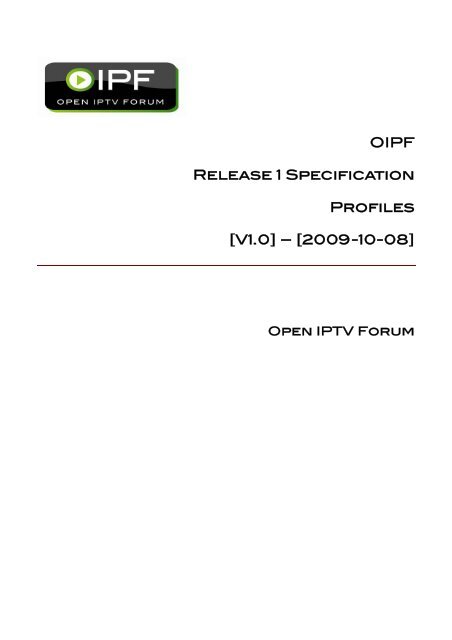
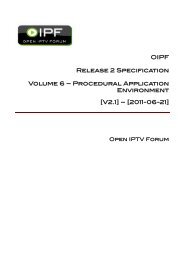

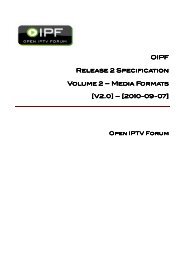




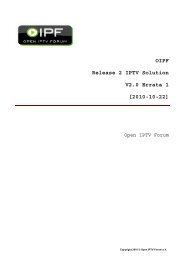

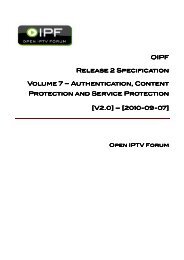

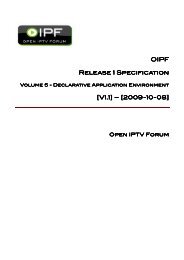
![Overview [V2.0] - Open IPTV Forum](https://img.yumpu.com/30169976/1/184x260/overview-v20-open-iptv-forum.jpg?quality=85)
